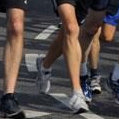 Business process management is all about people. This is also true for IDS Scheer itself. Therefore, from time to time we will show here in the ARIS BPM Blog those people and their interests. Today, we start with a report about an endurance run with over 12.000 participants two weeks ago.
Business process management is all about people. This is also true for IDS Scheer itself. Therefore, from time to time we will show here in the ARIS BPM Blog those people and their interests. Today, we start with a report about an endurance run with over 12.000 participants two weeks ago.
Every year in early summer, a small town in the Saarland region called Dillingen goes into a running frenzy. This time around, over 12.000 runners gathered to make this 5km corporate race the fifth-biggest event of its kind in Germany. Naturally, it’s a matter of honor for IDS Scheer to put in an impressive performance.
Just under forty runners represented IDS Scheer. Linking variable pay to taking part would doubtless achieve wonders, but for some reason my offhand suggestion here was met with considerable skepticism regarding its practicality...
The problem of covering the distance in the shortest possible time without collapsing breathless mid-route paled into insignificance compared to the challenge of finding the best starting position. Ideally, you want to be ahead of the slower runners so they don’t impede your progress, but you also don’t want to get in the way of the faster athletes. To make things easier, blocks are marked out, based on the expected running time.
Being an honest kind of guy, I get into position at the front of the 20-minute block — a decision that earns me merit points for fairness, but which was to have serious repercussions later on. We stand there, packed in. While we’re waiting for the starting signal, two presenters entertain us, doing a nice job of warming up the runners and spectators alike.
And then we’re off. Because the start line narrows slightly (each runner’s time is measured individually via an RFID chip attached to their shoelace), it takes a while for everyone to get moving. A good two minutes after the race officially begins, I finally cross the start line and try to get up to speed. Unfortunately, this proves very tricky, as it seems that most runners can’t gauge their ability particularly well — or just start at the front as a matter of principle. Permanently having to avoid slower people, speed up, slow down, look for gaps, avoid spectators and even some cars, which strangely are still parked on the course, quickly gets my heart rate up to 175, even though I’m still under my goal pace.
A race with this many participants is especially fun, because although people are passing you all the time, you can also overtake others. So it’s never boring and blasting past as many other runners as possible naturally gives you a psychological boost. The water station marks the halfway point. I ignore it — five kilometers is a pretty short distance and although it’s very warm, taking liquid onboard now would interrupt my rhythm rather than helping it.
The throng approaches the finish faster than anticipated. In front of me, I can see another IDS colleague, but unfortunately I’ve overexerted myself so much already that there’s no way I can catch him. Our running times surprise most people. Even I can’t quite believe I ran under 20 minutes because my training had been hampered by injury. It seems that the organizers were not quite accurate when measuring the course and let us off a couple of hundred meters. But hey, everyone benefited equally.
At the finish, it’s time to drink a non-alcoholic beer, collect my finishing medal, and return to the team tent. A couple of coworkers are already there, with the others gradually drifting back. Everyone is in upbeat mood and proud to have taken part — and to have made it to the finish.



